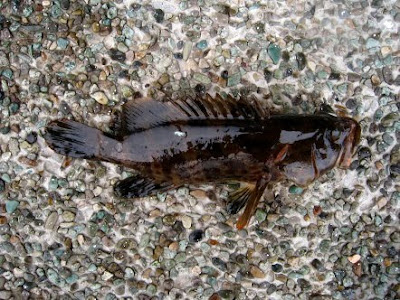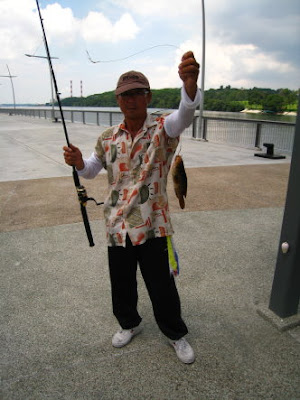Malabar Grouper or Kerapu Caught at Woodland Jetty

 Malabar Grouper also know as Gao Heurr 石班鱼 or Kerapu Caught at Woodland Jetty
Malabar Grouper also know as Gao Heurr 石班鱼 or Kerapu Caught at Woodland JettyMalabar Grouper [Epinephelus Malabaricus] also know as Gao Heurr 石班鱼[Chinese] or Kerapu [Malay] is common in rocky shorelines throughout the island. Its habitat is less widespread than the orange-spotted grouper, prefers shallow reefs and rocky banks such as breakwaters. They can adapt well to brackish water as well.
This carnivorous fish's wide range of diet and greedy behavoir makes it easy to catch. They typically take prawns, fishes, squids, worms or any form of meat. They aren't afraid to take down relatively big preys, infact using a bigger bait is actually more effective in catch them as opposed to using a smaller one (ie. small pieces of prawn meat). This is particularly true when aiming for larger groupers. Deep diving artificial lures work very well on them too.
Malabar Grouper [Epinephelus Malabaricus] also know as Gao Heurr 石班鱼[Chinese] or Kerapu [Malay] usually have a hiding place, usually among rocks to ambush prey. They will snipe the prey within range and will quickly dash back into its hiding place. Anglers must be anticipate for a grouper strike when fishing in rocky area. Response to a grouper hit must be swift and a little harsh initially to pull the grouper away from its hiding spot. If the grouper is given a chance to dive back into the rocks, it will erect its gill covers and use them to anchor itself firmly between rocks.
It is advised to use high abrasion resistant lines/thicker leaders when fishing for groupers. The rocky habitat and the grouper's sharp teeth are often causes of line snaps when fighting a grouper.

 Malabar Grouper also know as Gao Heurr 石班鱼 or Kerapu Caught by Ah Goh weighing 600gm plus at Woodland Jetty
Malabar Grouper also know as Gao Heurr 石班鱼 or Kerapu Caught by Ah Goh weighing 600gm plus at Woodland JettyLabels: Fishing Hotspots, Gao Heurr, Kerapu, Malabar Grouper, Pancing, Woodland Jetty, 石班鱼, 钓鱼


0 Comments:
Post a Comment
Subscribe to Post Comments [Atom]
<< Home